Occupational environment monitoring at the factory producing corrugated iron sheets
99,000 ₫
Note: The above price is calculated for one sample, the price may fluctuate depending on the area of the environment to be monitored and the movement of the market. For more accurate price support, please refer to the quotation table or contact directly with our consulting staff.
Environmental monitoring of corrugated iron sheet manufacturing factories is a session of collecting, analyzing, and evaluating factors in the workplace that may be harmful to the health of workers.
Table of Contents
Toggle1. Overview of the Corrugated Iron Sheet Factory
a. What is a corrugated iron sheet factory?
A manufacturing factory for corrugated iron sheets is a production facility specialized in processing and producing corrugated iron sheets, a type of building material made from thin steel sheets. Corrugated iron sheets are commonly used in construction, houses, warehouses, workshops, and other industrial projects.

b. Production stages in a corrugated iron sheet factory
A corrugated iron sheet factory usually has the following production stages and processes:
- Raw material preparation: The factory receives and inspects steel coils, which serve as the main raw material for producing corrugated iron sheets. Materials must meet standards for thickness, quality, and size.
- Steel cutting: Steel coils are cut into smaller sheets of the required size using steel cutting machines or plasma cutters.
- Processing and shaping: Steel sheets are fed into processing machines to shape and form them according to specific requirements. This process may include cold rolling, hot rolling, corrugating, shaping, and stamping.
- Coating: Corrugated iron sheets may be coated to protect them from environmental impacts. Coating methods include spraying or electrostatic coating.
- Quality inspection: Corrugated iron sheets are inspected to ensure compliance with standards regarding strength, size, shape, and coating quality.
- Packing and transportation: After quality inspection, the sheets are packaged appropriately for protection and convenient delivery to customers.

c. Machinery used in a corrugated iron sheet factory
In a corrugated iron sheet factory, various types of machinery are used to perform production processes. Below are some common machines in the corrugated iron sheet production process:
- Steel cutting machines: Used to cut steel coils into smaller sheets of the required size. Types include mechanical steel cutters, plasma cutters, and laser cutters.
- Corrugating machines: Used to process and shape steel sheets into corrugated iron sheets. Machines may operate with cold rolling or hot rolling, depending on the specific production process.
- Bending machines: Used to bend corrugated sheets into different shapes and sizes. Adjustable to create curves and angles as required.
- Welding machines: Used to weld sheets together to form components or finished products. Types include electric welders, spot welders, and MIG/MAG welders.
- Coating machines: Used to apply protective coatings on the surface of sheets. Technologies include spray coating or electrostatic coating for even and high-quality coverage.
- Other processing machines: Additional machines like stamping machines, cutting machines, polishing machines, and CNC processing equipment are used to complete processing and finishing steps.

d. Occupational diseases for workers in the corrugated iron sheet factory
Workers in corrugated iron sheet factories may face several occupational hazards and occupational diseases such as:
- Respiratory diseases: Workers may be exposed to fine particles, dust, and metal fumes from cutting, processing, and welding sheets, potentially causing asthma, pneumonia, and other lung diseases.
- Hearing problems: Noise from machinery and production processes can harm workers’ ears. Continuous exposure to high noise levels may lead to hearing loss or other auditory issues.
- Skin diseases: Chemicals used in coating and surface treatment can irritate the skin, causing dermatitis, rashes, or bleeding.
- Musculoskeletal problems: Lifting, twisting, bending, and cutting sheets may cause muscle strain, skeletal issues, and pain in muscles and spine.
- Risk of accidents: Working with machinery and sharp tools in an industrial environment may cause cuts, punctures, injuries, and burns.
To ensure safety and protect workers’ health, personal protective equipment must be used, including masks, safety glasses, helmets, gloves, ear protection, and protective clothing. In addition, maintaining safe work procedures, providing occupational safety training, and conducting regular health checks are critical.

e. Common types of corrugated iron sheets on the market
There are several types of corrugated iron sheets on the market, depending on use and technical requirements. Some common types include:
- Cold-rolled steel sheets: Produced through cold rolling of steel, with smooth and attractive surfaces. Used in exterior, interior, light industry, and packaging applications.
- Galvanized steel sheets: Coated with zinc to prevent oxidation and corrosion. Common in construction, roofing, and applications requiring high corrosion resistance.
- Corrugated sheets: Sheets with a wavy surface, used in construction of houses, warehouses, workshops, roofing, partitions, and similar applications.
- Aluminum sheets: Lightweight, durable, corrosion-resistant, and easy to process. Used in aerospace, automotive, construction, and electronics industries.
- Color-coated steel sheets: Coated with anti-corrosion paint and available in various colors. Used in buildings, villas, offices, interior decoration, and architectural projects.
- Insulated sheets: Constructed with two layers of steel with insulation in between. Used in facilities requiring thermal insulation, such as factories, cold storage, and food processing plants.
2. Overview of Occupational Environment Monitoring Services
a. What is occupational environment monitoring in a corrugated iron sheet factory?
Occupational environment monitoring (or workplace environment measurement) in a corrugated iron sheet factory involves collecting, evaluating, and analyzing workplace environmental factors to implement timely measures, minimize harmful effects on workers’ health, and prevent occupational diseases. Monitoring is mandatory for all corrugated iron sheet factories.
Occupational environment monitoring plays a crucial role in protecting and enhancing workers’ health because workers are the core resource generating direct profit for the business. Continuous exposure to hazardous factors beyond permitted levels may affect health and cause occupational diseases.
REGISTER FOR OCCUPATIONAL ENVIRONMENT MONITORING SERVICE
b. Nam Viet’s occupational environment monitoring program
Nam Viet’s occupational environment monitoring program is designed by engineers specializing in occupational safety and environmental protection. The program aims to ensure worker health and safety by using modern measurement methods to monitor air quality, water, microclimate factors, physical parameters, and dust in the workplace. It is vital for ensuring a safe working environment and protecting workers’ health.
Additionally, the program plays an important role in researching and developing solutions to improve workplace environment quality. With a dedicated and professional team, Nam Viet’s exclusive monitoring program is a breakthrough in occupational safety and environmental management in Vietnam.

c. Standardization in workplace measurement procedures
Standardization in Nam Viet’s workplace measurement procedures is crucial to ensure accurate and reliable results. The program follows recognized standards and procedures from the Ho Chi Minh City Department of Health. This guarantees that collected data are reliable for evaluating workplace conditions and making decisions to improve the work environment and protect workers’ health.
Standardized procedures ensure that measurements are conducted by experienced monitoring specialists, allowing managers and experts to trust Nam Viet’s results and make accurate decisions to protect worker health and the environment.
By applying standardized procedures, Nam Viet demonstrates its commitment to ensuring a safe working environment and contributing to improving occupational safety and environmental management quality in Vietnam.
d. Occupational environment monitoring report for corrugated iron sheet factories
The monitoring report is prepared according to Form No. 04, Appendix III, issued with Decree 44/2016/ND-CP and is produced in 2 copies: 1 copy is sent to the contracted workplace, and 1 copy is kept by the monitoring organization.
Records must be kept indefinitely according to legal regulations.

e. Frequency of occupational environment monitoring according to law
According to Clause 2, Article 18 of the Law on Occupational Safety and Hygiene 84/2015/QH13, employers must conduct occupational environment monitoring to assess harmful factors at least once a year.
f. Deadline for submitting monitoring reports according to law
The deadline for submitting reports is before December 31 each year. Enterprises at manufacturing facilities must submit monitoring reports to the Department of Health at the location of the main office and where workers are employed.
When there are changes in technology, production processes, or facility renovations/upgrades that may introduce new hazards, enterprises must update their occupational hygiene records regarding harmful factors requiring monitoring.
g. Penalties for violations of occupational environment monitoring by employers
According to Article 27 of Decree No. 12/2022/ND-CP dated January 17, 2022, governing administrative penalties in labor, social insurance, and Vietnamese workers working abroad under contract:
- Clause 2: Fines from 2,000,000 – 5,000,000 VND for employers failing to publicly inform workers at the monitoring site and workplaces about monitoring results and risk assessments immediately after receiving results.
- Clause 3: Fines from 20,000,000 – 40,000,000 VND for employers failing to conduct monitoring to control harmful effects on workers’ health as required by law.
- Clause 4: Fines from 40,000,000 – 60,000,000 VND for employers collaborating with monitoring organizations to commit fraud in monitoring activities but not reaching the level of criminal liability.
3. Harmful environmental factors for workers in corrugated iron sheet production factories
Workers in corrugated iron sheet factories may be exposed to the following harmful environmental factors:
- Dust: The cutting, processing, and treatment of corrugated iron sheets can generate metal dust and sheet dust. Long-term inhalation of metal and sheet dust can cause respiratory issues and lung damage.
- Chemical fumes: Chemicals such as solvents, detergents, and paint coatings used during coating and surface treatment may release fumes that irritate the respiratory system and skin, causing health problems.
- Noise: Machinery and production processes in corrugated iron sheet factories can produce high levels of noise. Continuous and loud noise can cause stress, hearing damage, and other auditory problems.
- Temperature: Work environments in sheet factories may have high temperatures due to processing and the use of heat-generating equipment. High temperatures can cause discomfort, fatigue, and risk of burns or heat-related injuries.
- Mechanical hazards: Sharp machinery and equipment during production can pose risks of occupational accidents, such as cuts, punctures, and injuries.
- Electrical hazards: During production, there is a risk of contact with high voltage and electrical equipment, which can endanger workers.
REGISTER FOR OCCUPATIONAL ENVIRONMENT MONITORING SERVICE
4. Measures to improve the working environment in corrugated iron sheet factories
To improve the working environment in corrugated iron sheet factories and protect workers’ health, the following measures can be applied:
- Dust management: Ensure efficient ventilation systems in the factory and use dust extraction and air filtration systems to reduce dust during production. Also, ensure personal protective measures such as masks to prevent inhalation of dust.
- Temperature control: Provide air conditioning systems or cooling measures to reduce working temperatures in the factory. Also, ensure the use of protective equipment such as heat-resistant clothing and gloves to protect workers from heat exposure.
- Noise control: Implement soundproofing and insulation measures in the factory to reduce noise. Additionally, provide noise-canceling headphones for workers in high-noise areas.
- Machinery safety: Regularly maintain and inspect machinery and equipment to ensure safe operation and reduce the risk of accidents. Train staff on safe machine operation and apply safety measures when working near hazardous equipment.
- Electrical safety: Conduct regular inspection and maintenance of electrical systems to ensure safety and prevent electrical hazards. Train staff on safe use of electrical equipment and apply protective measures near electrical sources.
- Training and supervision: Ensure employees are trained in safe working procedures, PPE usage, and environmental risk handling. Conduct regular supervision to ensure compliance with safety regulations and health protection measures.
- Encourage participation and feedback: Foster an open work environment that encourages workers to participate in improving the workplace and provide feedback on health and safety issues.
- Periodically conduct occupational environment monitoring in factories to collect and analyze harmful factors affecting workers, then adjust measures to reduce risks and prevent occupational diseases.
5. Benefits of periodic monitoring in corrugated iron sheet factories
An Toan Nam Viet provides businesses with excellent advantages when using occupational environment monitoring services according to Decree 44/2016/ND-CP on managing and controlling harmful factors in the workplace affecting employees.
- Businesses can proactively control harmful factors in workshops or factories.
- Receive recommendations on measures to reduce harmful factors and improve workplace quality.
- Indirectly protect human resources, a key factor in business development.
- Reduce the harmful impact of occupational diseases on health, minimizing future treatment costs.
- Improve worker health, ensuring product quality and maintaining production output.
- Ensure compliance with labor safety laws and avoid legal risks.
- Enhance credibility and professionalism in all aspects, elevating the company brand.
Nam Viet’s environmental monitoring service is a solution to reduce occupational disease risks, contributing to a clean and high-quality working environment.

6. National occupational environment monitoring center
Occupational environment monitoring center of Nam Viet is a professional unit for supervising and measuring workplace environmental quality across all provinces in Vietnam. With a team of experienced monitoring specialists, the center uses modern measurement equipment to ensure accuracy and reliability.
In addition to monitoring services, the center assists clients in planning, managing, and tracking workplace environmental issues. With the motto “customer-centered,” the center prioritizes customer satisfaction, meets all client needs, and is committed to providing the best solutions for businesses.
REGISTER FOR OCCUPATIONAL ENVIRONMENT MONITORING SERVICE
With investments in technology, equipment, and human resources, Nam Viet’s monitoring center has become one of the most reputable units in occupational environment monitoring in Ho Chi Minh City, with the following objectives:
- We always value our brand reputation and service quality.
- We provide clients with the best and most suitable solutions possible.
- Alongside a team of experienced Masters and Engineers, committed to environmental protection and business benefit.
- At Nam Viet Environmental Monitoring, companies receive professional service from field experts and the best cost advantages.
The occupational environment monitoring process at Nam Viet includes the following basic steps:
- Before conducting monitoring, our company ensures all equipment is calibrated according to legal regulations.
- Follow the occupational environment monitoring procedures committed to the Department of Health accurately and fully.
- Report monitoring results honestly to employers.
- If monitoring results indicate unsafe conditions, Nam Viet provides corrective solutions, and the workplace implements the following:
- Implement measures to improve working conditions, minimize harmful factor impacts, and prevent occupational diseases.
- Conduct health examinations to detect occupational and related diseases early for workers in unsafe environments.
- Provide in-kind compensation to workers according to labor law.

7. Occupational environment monitoring quotation
To help businesses conduct professional and effective occupational environment monitoring, Nam Viet provides clients with a quotation for occupational environment monitoring services with quality and reasonable costs.
- Our quotation provides detailed pricing information for the monitoring services we offer, including costs related to travel, measurement, analysis, and reporting. Clients can trust the accuracy and reliability of the monitoring reports we provide.
- We commit to offering competitive and reasonable prices in the market and are always ready to provide quick and professional advice for any inquiries regarding monitoring services.
- With Nam Viet’s monitoring quotation, clients can easily select service packages suitable to their needs. We are committed to delivering the highest satisfaction with professional service quality.
No comments yet

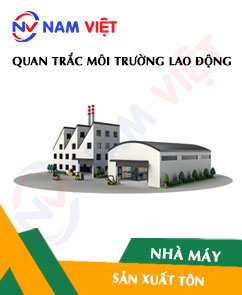
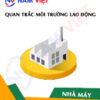
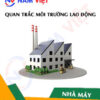

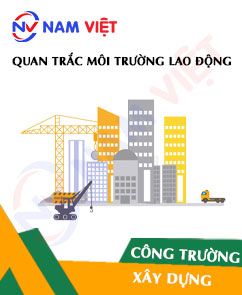

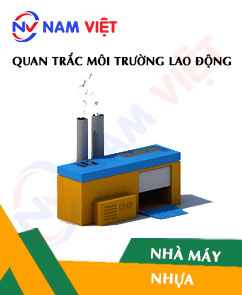
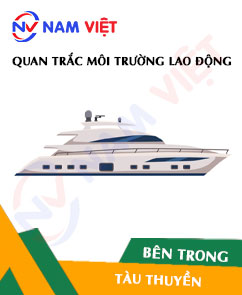


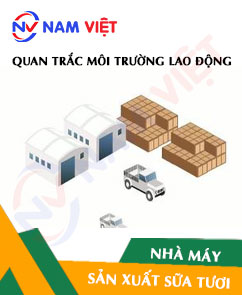
Review Occupational environment monitoring at the factory producing corrugated iron sheets
There are no reviews yet.